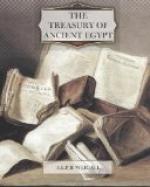The religious teachings of the Egyptians before the Ptolemaic era do not suggest that the mortification of the flesh was a possible means of purifying the spirit. An appeal to the senses and to the emotions, however, was considered as a legitimate method of reaching the soul. The Egyptians were passionately fond of ceremonial display. Their huge temples, painted as they were with the most brilliant colours, formed the setting of processions and ceremonies in which music, rhythmic motion, and colour were brought to a point of excellence. In honour of some of the gods dances were conducted; while celebrations, such as the fantastic Feast of Lamps, were held on the anniversaries of religious events. In these gorgeously spectacular ceremonies there was no place for anything sombre or austere, nor could they have been conceived by any but the most life-loving temperaments.
As in his religious functions, so in his home, the Egyptian regarded brilliancy and festivity as an edification. When in trouble or distress, he was wont to relieve his mind as readily by an appeal to the vanities of this world as by an invocation of the powers of Heaven. Thus, when King Sneferu, of Dynasty IV., was oppressed with the cares of state, his councillor Zazamankh constructed for him a pleasure boat which was rowed around a lake by the most beautiful damsels obtainable. And again, when Wenamon, the envoy of Herhor of Dynasty XXI., had fallen into trouble with the pirates of the Mediterranean, his depression was banished by a gift of a dancing-girl, two vessels of wine, a young goat of tender flesh, and a message which read—“Eat and drink, and let not thy heart feel apprehension.”
An intense craving for brightness and cheerfulness is to be observed on all sides, and the attempt to cover every action of life with a kind of lustre is perhaps the most apparent characteristic of the race. At all times the Egyptians decked themselves with flowers, and rich and poor alike breathed what they called “the sweet north wind” through a screen of blossoms. At their feasts and festivals each guest was presented with necklaces and crowns of lotus-flowers, and a specially selected bouquet was carried in the hands. Constantly, as the hours passed, fresh flowers were brought to them, and the guests are shown in the tomb paintings in the act of burying their noses in the delicate petals with an air of luxury which even the conventionalities of the draughtsman cannot hide. In the women’s hair a flower was pinned which hung down before the forehead; and a cake of ointment, concocted of some sweet-smelling unguent, was so arranged upon the head that, as it slowly melted, it re-perfumed the flower. Complete wreaths of flowers were sometimes worn, and this was the custom as much in the dress of the home as in that of the feast. The common people also arrayed themselves with wreaths of lotuses at all galas and carnivals. The room in which a feast was held was decorated lavishly with flowers. Blossoms crept up the delicate pillars to the roof; garlands twined themselves around the tables and about the jars of wine; and single buds lay in every dish of food. Even the dead were decked in their tombs with a mass of flowers, as though the mourners would hide with the living delights of the earth the misery of the grave.




